Home » Gemstones » Strawberry Quartz
Strawberry Quartz
Colorless quartz colored pink to red by inclusions of other minerals.
Author: Hobart M. King, PhD, GIA Graduate Gemologist
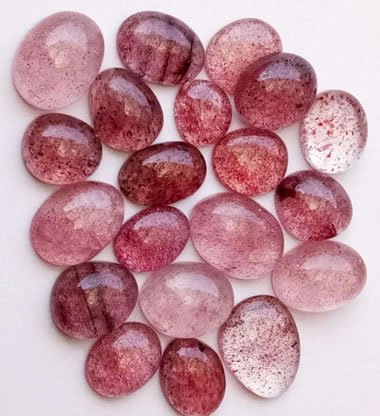
Strawberry Quartz: A collection of beautiful strawberry quartz cabochons in a range of wonderful pink to red colors. The intensity of red color is related to the number of red mineral inclusions and their distribution within the stone. Photograph from Urvi Agrawal of gemsforjewels.
What is Strawberry Quartz?
"Strawberry quartz" is a novelty gem and a marketing term used for specimens of pink to red quartz or quartzite that receive their color from eye-visible mineral inclusions.
The inclusions can be small platelets of hematite, flakes of lepidolite, flakes of alurgite (a orangy red muscovite), crystals of piemontite, or other minerals that are pink to red in color. The visible inclusions contribute to the name of strawberry quartz because their appearance can be similar to strawberry seeds.
Table of Contents
 Uses of Strawberry Quartz Uses of Strawberry Quartz Single-Crystal and Granular Quartz Single-Crystal and Granular Quartz Quality Factors Quality Factors Strawberry Quartz vs Rose Quartz Strawberry Quartz vs Rose Quartz Imitation Strawberry Quartz Imitation Strawberry Quartz When is it Imitation? When is it Fake? When is it Imitation? When is it Fake? |
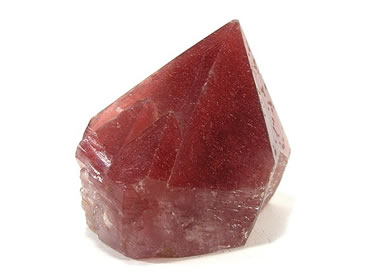
Strawberry Quartz Crystal: This collector-grade specimen perfectly fits the definition of "strawberry quartz". It is a terminated quartz crystal that is packed with tiny acicular crystals of reflective red hematite. Although the red hematite crystals account for a small volume of the specimen, they fill the quartz crystal with a wonderful red color and give it an aventurescent reflectance. This specimen was collected near Chihuahua, Mexico and measures about 5.7 x 5.5 x 4 centimeters in size. Specimen and photo by Arkenstone / www.iRocks.com.
Uses of Strawberry Quartz
The most popular use of strawberry quartz is in jewelry. Strawberry quartz makes beautiful cabochons, beads, bangles, and faceted gems.
Although strawberry quartz is rare, it remains an inexpensive gem. That allows it to be made into inexpensive jewelry using sterling silver or 10 karat gold mountings. The buyer might splurge on a 14 karat rose gold mounting. (We are waiting for Le Vian to mount strawberry quartz stones in their trademarked strawberry gold mountings.)
Strawberry quartz specimens, tumbled stones, cabochons, and other strawberry quartz items are popular with gemstone collectors, mineral collectors, and lapidary enthusiasts. They can also be made into unique jewelry items that are both interesting and attractive.
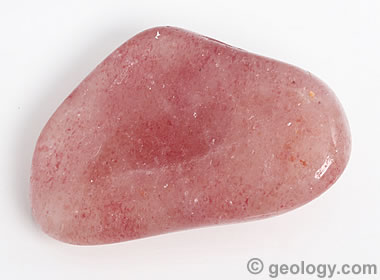
Strawberry Aventurine: This tumbled stone is made up of quartzite that obtains its pink color from tiny flakes of pink mica (lepidolite). The flakes of pink mica are in a subparallel alignment that enables them to simultaneously reflect incident light. These simultaneous reflections produce a property known as aventurescence, and thus the name "strawberry aventurine". Click here for a close-up view that shows how few flakes of lepidolite are needed to impart the strawberry color.
Aventurine occurs in many different colors and aventurescence is displayed by many different gem minerals. See our article about aventurine.
Single-Crystal and Granular Quartz
Most specimens of strawberry quartz consist of single quartz crystals with included red minerals (see accompanying photo). However, some specimens consist of granular quartz in the form of quartzite with inclusions of lepidolite or alurgite mica (see accompanying photo).
Quartzite is a metamorphic rock that forms when a sandstone is subjected to heat and pressure. This type of strawberry quartz is often aventurescent because during metamorphism the mica grains in the rock are orientiented with their reflective surfaces perpendicular to the direction of metamorphic compression.
That enables them to produce the simultaneous reflections known as aventurescene. These specimens are often marketed as "pink aventurine" or "strawberry aventurine" (see accompanying photo).
| The Fall 2021 issue of Gems & Gemology has an article that features three interesting photos: 1) a bangle made from strawberry quartz; 2) a photomicrograph of hematite flakes in strawberry quartz; and, 3) a photomicrograph of red muscovite (alurgite) inclusions in pink aventurine. You can find it here: Pink Aventurine Quartz with Alurgite Inclusions, by Shu-Hong Lin, Yu-Ho Li, and Huei-Fen Chen; Gems & Gemology, Fall 2021, Volume 57, Number 3, pages 282 to 283. |
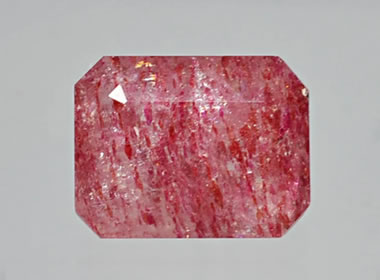
A Rare Source of Strawberry Color: This faceted specimen of strawberry quartz gets the "strawberry" part of its name from a rare and unusual mineral named piemontite. Piemontite is a manganese member of the epidote mineral family. Tiny inclusions of piemontite are responsible for the red color of the stone. This gem measures 7.80 x 7.60 x 5.00 millimeters and weighs 2.87 carats. Specimen and photo by Max Davis of Gemological Collections.
Strawberry Quartz Quality Factors
The most desirable pieces of strawberry quartz have a distinctly pink or red color without traces of other hues. Their color is uniform across the face of the gem.
The inclusions should be large enough to be eye-visible but not so large that surface-reaching inclusions leave a noticeable pit on the surface of the gem. Reflective inclusions that produce an aventurescent or chatoyant effect when the gem is viewed in the face-up position will strongly appeal to some buyers.
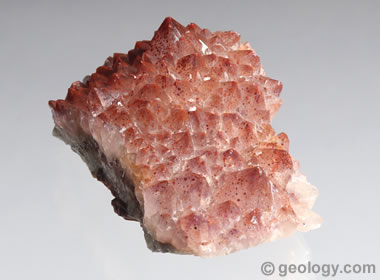
Strawberry Amethyst? A tight cluster of strawberry quartz crystals with a slightly purplish-red color. Take a close look, and you might notice that the quartz crystals are actually a very light amethyst with red inclusions (of what appear to be hematite) producing the dominant red color. The specimen is from the Thunder Bay District of Ontario, Canada. It measures approximately 7.0 x 3.8 x 2.5 centimeters in size. Click here for a more detailed view of the specimen.
Strawberry Quartz vs Rose Quartz
Strawberry quartz and rose quartz are two different materials. The pink to red color of strawberry quartz is caused by light reflecting from tiny mineral particles included in the quartz.
However, the color of rose quartz is thought to be caused by trace amounts of titanium, iron, or manganese within the quartz, or by very fine strands of a rare pink variety of dumortierite. [2]
| An article in Engineering and Science explains an origin for pink color in rose quartz. Light interacting with fine strands of a pink variety of dumortierite produce the pink color and the typical translucence of the material. You can find it here: The Secret Lives of Minerals by Elisabeth Nadin: Engineering and Science, Volume 70, Number 1, pages 10-20, 2007 |
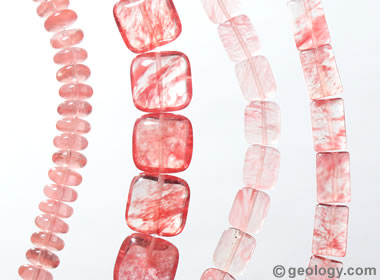
Imitation Strawberry Quartz: Glass beads that were made to resemble strawberry quartz. If you look closely, you can see tiny gas bubbles trapped within the glass. Click here to enlarge image.
Imitation Strawberry Quartz
Strawberry quartz is very popular and abundant, however, material with a superb color and appearance is rare. Nature does not provide enough superb strawberry quartz to meet the demand. So, numerous people have figured out how to make materials that look just like strawberry quartz.
The most common imitation is made by melting glass and mixing in particles of hematite or another red material. When made skillfully, imitation strawberry quartz can have a very attractive color and a convincing scatter of inclusions.
Some people might be angry about these imitation materials and call them "fakes"; however, they are simply a man-made product and perfectly legal. As long as the seller informs potential customers that they are buying a man-made product and not a creation of nature, they have done their legal duty.
To prevent misunderstandings, the seller should not offer the item for sale as "strawberry quartz". Instead they should offer it as "imitation strawberry quartz" or "strawberry quartz glass".
| Strawberry Quartz Information |
|
[1] Rose Quartz: A mineral species article on the mindat.org website, accessed March 2022.
[2] Fibrous nanoinclusions in massive rose quartz: The origin of rose coloration: by Julia S. Goreva, Chi Ma, and George R. Rossman; American Mineralogist, Volume 86, pages 466–472, 2001. Accessed March 2022 from the California Institute of Technology website. |
When is it Imitation? When is it "Fake"?
An item is imitation when the seller knows that the item is imitation and clearly discloses that it is man-made to the customer. Before money changes hands, the seller must informs the buyer that the item being purchased is not a natural material - that means people had a hand in producing it. The seller meets their duty of making sure that the buyer understands that the item is an imitation. This is known as a meeting of the minds.
Four things occur in the best possible transaction: 1) the seller clearly informs the buyer that the material is imitation (meaning made by people, or not natural), 2) the buyer understands that the material is imitation, 3) the item is marked man-made or imitation, and, 4) the bill of sale also documents that the item is imitation.
An item is a "fake" when the seller knows that the item is an imitation material, presents it to the buyer as if it were natural, and accepts the buyer's money without the buyer understanding that an imitation material was purchased. If a seller gets caught knowingly selling imitation materials as natural materials they could be subject to civil or criminal liability.
| More Gemstones |
 |
Tourmaline |
 |
Fancy Sapphires |
 |
Diamond |
 |
Canadian Diamond Mines |
 |
Birthstones |
 |
Pictures of Opal |
 |
Fire Agate |
 |
Blue Gemstones |

Find Other Topics on Geology.com:

|

| ||

|

| ||

|

| ||

|

|
